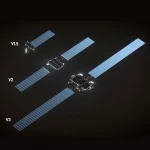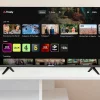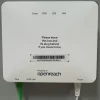Tiny LiFi LED Lights Set to Deliver WiFi Style Internet Communications
Researchers from the University of Strathclyde in Scotland (UK) have begun to develop a new Light Fidelity (Li-Fi) technology that could turn ordinary LED (Light-Emitting Diode) based home and office lighting or computer displays into a sophisticated wireless communications network like WiFi.
Back in 2011 German scientists succeeded in creating an 800Mbps (Megabits per second) capable wireless network by using nothing more than normal red, blue, green and white LED light bulbs (here), thus the idea has been around for awhile and various other global teams are also exploring the possibilities.
Advertisement
But the University of Strathclyde is leading a consortium of UK universities, funded by the Engineering and Physical Sciences Research Council (EPSRC), to develop its own “radical” and “distinctive vision” for the technology that it claims “could deliver enormous benefits“.
Professor Martin Dawson, Strathclyde University, explained:
“The Universities of Cambridge, Edinburgh, Oxford and St Andrews are all working with us, bringing specific expertise in complementary areas that will equip the consortium to tackle the many formidable challenges involved – in electronics, computing and materials, for instance – in making this vision a reality. This is technology that could start to touch every aspect of human life within a decade.
Imagine a LED array beside a motorway helping to light the road, displaying the latest traffic updates and transmitting internet information wirelessly to passengers’ laptops, netbooks and smartphones. This is the kind of extraordinary, energy-saving parallelism that we believe our pioneering technology could deliver.”
The principal is simple. LED lights flicker on and off thousands of times a second and by altering the length of the flickers you can introduce digital communications (a bit like flashing a torch to send Morse Code). Most of the other teams are developing Li-Fi LEDs of around 1mm2 in size, while the four-year initiative at Strathclyde University plans micron-sized LEDs.
The smaller micron-sized LEDs are able to flicker on and off around 1,000 times quicker than the larger LEDs. This offers faster data transfers and they also take up less space, which means you could use fewer and save space or add more to further boost the channels of communication (each LED can act as a separate channel).
Each micron-sized LED would also act as a tiny pixel. This means one large LED array display – such as one that might be used to light a living room or the interior of an aircraft – could also be used as a screen displaying information, at exactly the same time as providing internet communications and lighting. Clever stuff.
Advertisement
On the other hand light does have a few rather obvious drawbacks. For example, visible light cannot penetrate through most walls and is easily blocked by somebody simply walking in front of the LED source. In other words it probably won’t replace your wifi network anytime soon but further down the road.. who knows.
Mark is a professional technology writer, IT consultant and computer engineer from Dorset (England), he also founded ISPreview in 1999 and enjoys analysing the latest telecoms and broadband developments. Find me on X (Twitter), Mastodon, Facebook, BlueSky, Threads.net and Linkedin.
« UK ISP Zen Internet Launch NGA Ethernet Service via FTTC and FTTP


















































Comments are closed